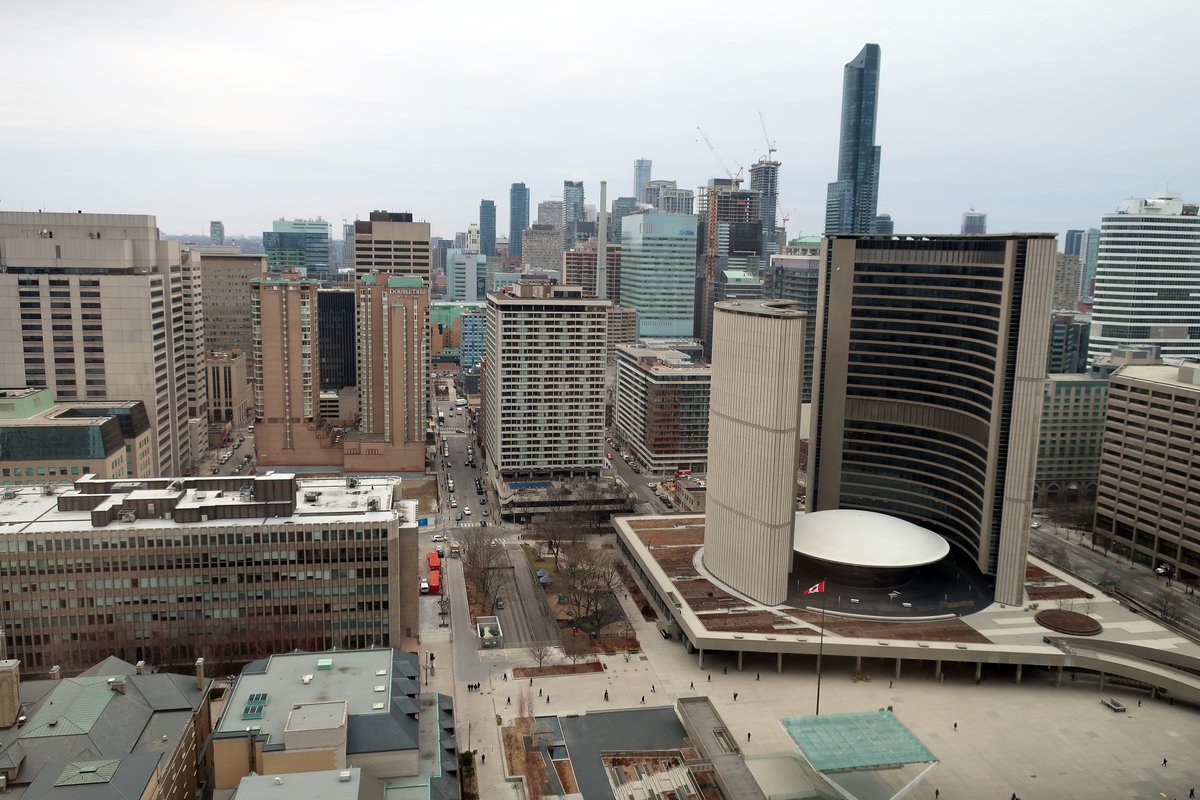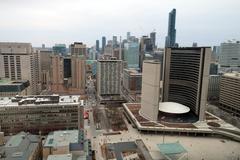
Toronto City Hall Visiting Guide: History, Significance, Tickets, and Visitor Tips
Date: 14/06/2025
Introduction
Toronto City Hall is a striking symbol of modernist architecture, civic engagement, and urban innovation, located at the heart of downtown Toronto. Designed by Finnish architect Viljo Revell and inaugurated in 1965, it stands as a testament to Toronto’s mid-20th-century growth and progressive ambitions. Its two curving towers—distinctly embracing a saucer-shaped council chamber—define the city skyline and anchor Nathan Phillips Square, a vibrant public plaza that hosts major events, markets, and year-round attractions (The Canadian Encyclopedia; Wikipedia).
This guide provides a comprehensive overview for travelers and locals, covering Toronto City Hall’s history, architectural significance, practical visitor information (including hours, accessibility, and ticketing), and tips for making the most of your visit. Whether you’re an architecture enthusiast, cultural explorer, or first-time visitor, this article will help you experience the best of Toronto’s civic hub.
Table of Contents
- Introduction
- Origins and Historical Context
- Architectural Significance
- Visitor Information
- Nathan Phillips Square
- Comparative Insights: Toronto City Hall and Global Counterparts
- Frequently Asked Questions (FAQs)
- Conclusion & Final Tips
- References and Further Reading
Origins and Historical Context
Toronto’s Old City Hall, opened in 1899 and designed by Edward James Lennox, was once North America’s largest city hall, but by the 1950s, it could no longer support the city’s burgeoning population or administrative needs (The Canadian Encyclopedia; Storeys). After a rejected design proposal in 1955, the city launched an international competition in 1958, receiving over 500 entries from 42 countries. Viljo Revell’s bold vision won the contest, and construction began in 1961, culminating in 1965. Revell, who sadly passed away before the building’s completion, left a lasting mark on Toronto’s architectural landscape (Wikipedia).
Architectural Significance
Design Philosophy and Structure
Revell’s design marked a radical departure from traditional municipal architecture. The two asymmetrical curving towers (27 and 20 stories) wrap around the central, saucer-shaped council chamber, an arrangement symbolizing transparency and civic engagement (PFI Mag). The complex includes:
- Circular Council Chamber: The centerpiece for city council meetings.
- Podium: A two-storey base hosting city services.
- Nathan Phillips Square: A public plaza supporting gatherings and events.
Materials and Construction
The building makes extensive use of precast concrete, glass, and aluminum, allowing for ample natural light and a futuristic, open aesthetic. Elevated colonnaded walkways and concrete arches further highlight its innovative structure (PFI Mag).
Symbolism and Urban Impact
Initially polarizing, Toronto City Hall became a beloved symbol of the city’s diversity and forward-looking spirit. It was designated a National Historic Site in 1996, a recognition of its influence on Canadian urban design and identity (The Canadian Encyclopedia).
Notable Features and Public Art
- “Toronto” Sign: Installed in 2015, it’s now an enduring landmark and photo hotspot (PFI Mag).
- Reflecting Pool and Freedom Arches: The pool becomes a skating rink in winter; the arches symbolize unity.
- Public Art: The square features sculptures and installations, including the Peace Garden.
Relationship with Old City Hall
Old City Hall, a Romanesque Revival masterpiece, stands just east of the new City Hall, now serving as a courthouse. Its Victorian grandeur complements the modernism of its successor, together representing Toronto’s architectural evolution (Storeys).
Visitor Information
Visiting Hours
- City Hall Interior: Open Monday to Friday, typically 8:30 AM to 5:00 PM. Some areas may be restricted during meetings or events.
- Nathan Phillips Square: Open 24/7 all year.
For the latest updates, consult the official City of Toronto website.
Tickets and Admission
- Admission: Free for both City Hall and Nathan Phillips Square. No tickets required for general access.
- Special Events: Certain guided tours or events may require advance registration.
Guided Tours
The City of Toronto occasionally offers free guided tours, providing insights into the building’s architecture, history, and civic functions. Advance booking is recommended, especially for groups. Visit the City Hall Tours page for current schedules.
Accessibility
Toronto City Hall is fully accessible:
- Entrances: Barrier-free access via ramps and elevators. Primary accessible entry is on the Hagerman/Elizabeth Street side (City Accessibility).
- Facilities: Accessible washrooms, elevators, tactile signage, and support for those with visual or hearing impairments.
- Service Animals: Permitted throughout.
- Security Screening: All visitors pass through security; accessible screening is provided at designated entrances (Visitor Screening).
Nearby Attractions and Tips
- Toronto Eaton Centre: A premier shopping destination nearby.
- Art Gallery of Ontario & Financial District: Within easy walking distance.
- Transit: Use Queen or Osgoode subway stations, or streetcars. Parking is limited; public transit is recommended.
- Amenities: Information desk, café, public washrooms, and free Wi-Fi.
Nathan Phillips Square
Location and Layout
Nathan Phillips Square, in front of City Hall at 100 Queen St W, is bordered by Queen Street West, Bay Street, and Osgoode Lane. It’s easily accessible via subway, streetcar, or bus (CityPASS; Ultimate Ontario).
Year-Round Attractions
- Reflecting Pool & Skating Rink: The pool is a summer focal point and a popular winter skating spot with rentals available (Celebrate Toronto).
- Farmers’ Market: Weekly market in warmer months.
- Public Art & Seasonal Installations: Includes the Peace Garden and rotating exhibits (Woke Waves).
Signature Events and Festivals
Nathan Phillips Square is Toronto’s central gathering space, hosting:
- Celebrate Toronto: Annual spring festival with vendors, music, and fireworks (Celebrate Toronto).
- Nuit Blanche: All-night art extravaganza each fall (Woke Waves).
- Multicultural Festivals: Pride, Caribbean Carnival, Taste of India/Vietnam, Portugal Day, and more (Toronto Events Calendar).
- Civic Ceremonies: Remembrance Day, Orange Shirt Day, and others (City of Toronto).
Visitor Amenities
- Accessibility: Ramps, elevators, and accessible washrooms.
- Food: Food trucks and market stalls, especially during events (Ultimate Ontario).
- Wi-Fi & Services: Free Wi-Fi, information kiosks, and event staff.
- Parking: Limited underground parking beneath the square; accessible spaces available.
Comparative Insights: Toronto City Hall and Global City Halls
Toronto City Hall’s modernist curves and open plaza set it apart from the historicist grandeur of other famous city halls:
- San Francisco City Hall: Beaux-Arts with a massive dome (art-facts.com).
- Vienna Rathaus: Gothic Revival with ornate towers (art-facts.com).
- Stockholm City Hall: National Romantic, famed for Nobel banquets (art-facts.com).
- Manchester Town Hall: Victorian Gothic Revival (art-facts.com).
Toronto’s City Hall, chosen through an international competition, reflects the city’s aspirations for innovation and openness, blending government with a dynamic public space (historyoftoronto.ca; torontoforyou.com).
Frequently Asked Questions (FAQs)
Q: What are Toronto City Hall visiting hours?
A: City Hall is open Monday–Friday, 8:30 AM–5:00 PM; Nathan Phillips Square is open 24/7.
Q: Is admission free?
A: Yes. Both City Hall and the square are free to enter.
Q: Are guided tours available?
A: Yes, often free; booking in advance is recommended.
Q: Is the site accessible?
A: Fully accessible, with ramps, elevators, and accessible washrooms.
Q: Can I skate at Nathan Phillips Square?
A: Yes, the reflecting pool becomes a public skating rink in winter, with rentals available.
Q: Where can I park?
A: Underground parking (including accessible spaces) is available under the square; public transit is preferred due to limited spots.
Q: Are service animals allowed?
A: Yes, throughout the premises.
Conclusion & Final Tips
Toronto City Hall is more than a government building: it’s a living symbol of Toronto’s multicultural identity, architectural ambition, and community spirit. Its innovative design, free public access, and year-round programming make it an essential stop for any Toronto visitor.
For the latest information on hours, tours, and events, check the official City of Toronto website. Download the Audiala app for real-time updates, and explore related articles for more insights into Toronto’s top landmarks.
Embrace the opportunity to experience the architectural excellence, vibrant festivals, and inclusive spirit that Toronto City Hall and Nathan Phillips Square offer to every visitor.
References and Further Reading
- The Canadian Encyclopedia – Toronto City Hall
- Wikipedia – Toronto City Hall
- Storeys – Old City Hall Museum
- Ultimate Ontario – Nathan Phillips Square Guide
- City of Toronto – Visitor Information
- City of Toronto – Tours and Accessibility
- CityPASS – City Hall & Nathan Phillips Square
- PFI Mag – Interesting Facts
- Icy Canada – Significance of City Hall
- SeeSight Tours – Toronto Tours
- The Broke Backpacker – Toronto Itinerary
- Woke Waves – Toronto Festivals 2025 Guide
- Celebrate Toronto – Events
- Toronto Events Calendar – Nathan Phillips Square
- City of Toronto – Accessibility
- City of Toronto – Visitor Screening
- historyoftoronto.ca – Iconic Landmarks
- art-facts.com – City Hall Buildings
- torontoforyou.com – Discover Downtown
- denhamandbrown.com – Old City Hall
- mikeandlauratravel.com – Is Toronto Worth Visiting?
- Festival Toronto – Nathan Phillips Square
- All Events In – Nathan Phillips Square



























































































































































































